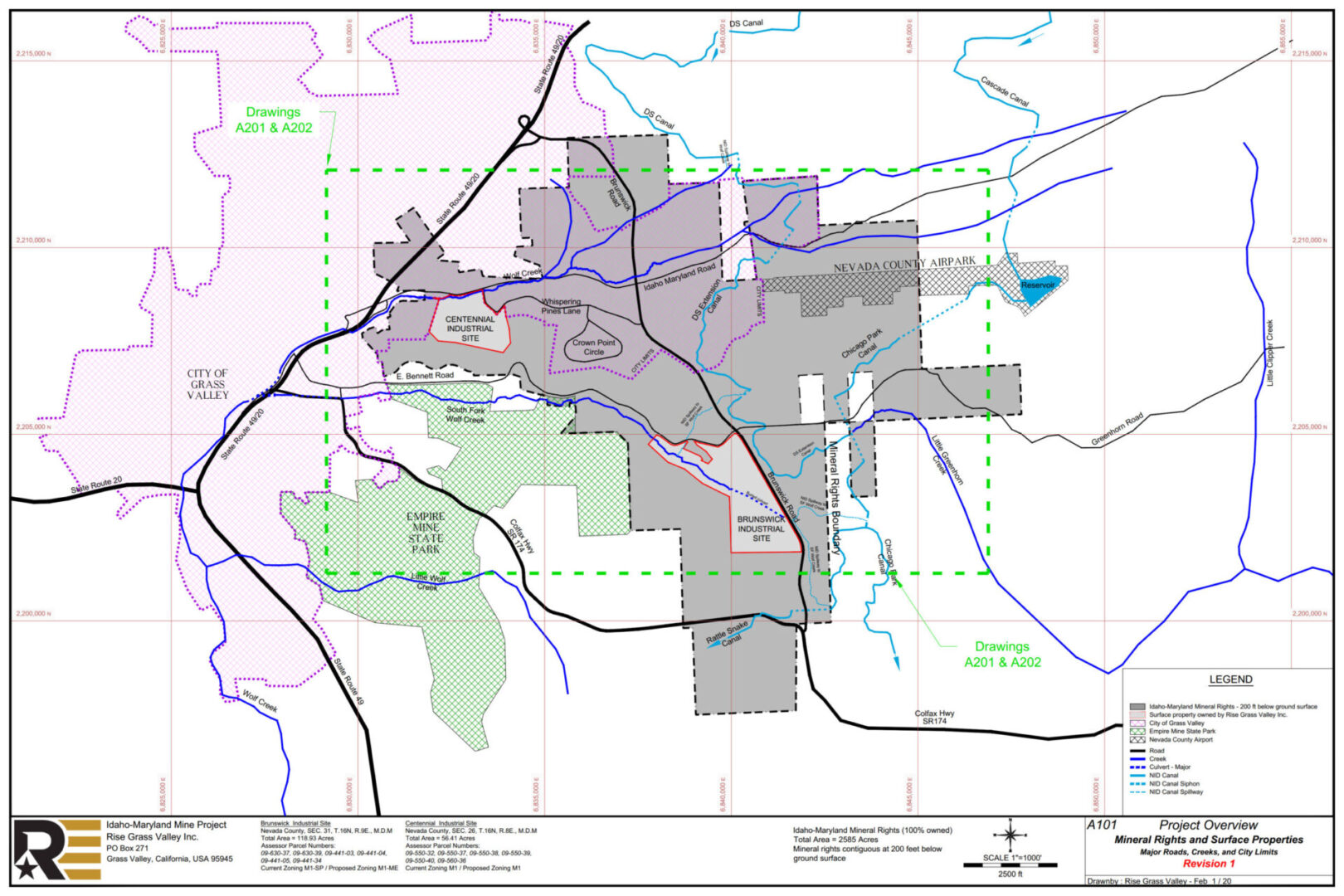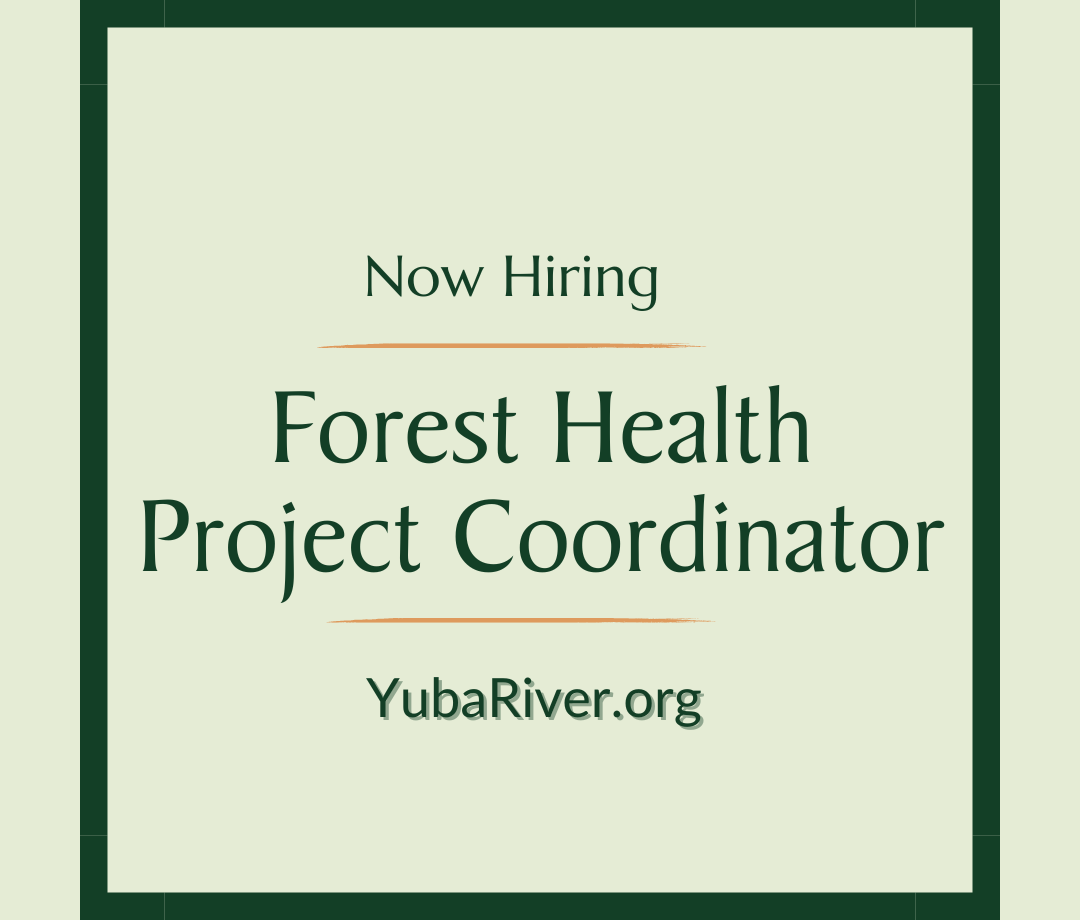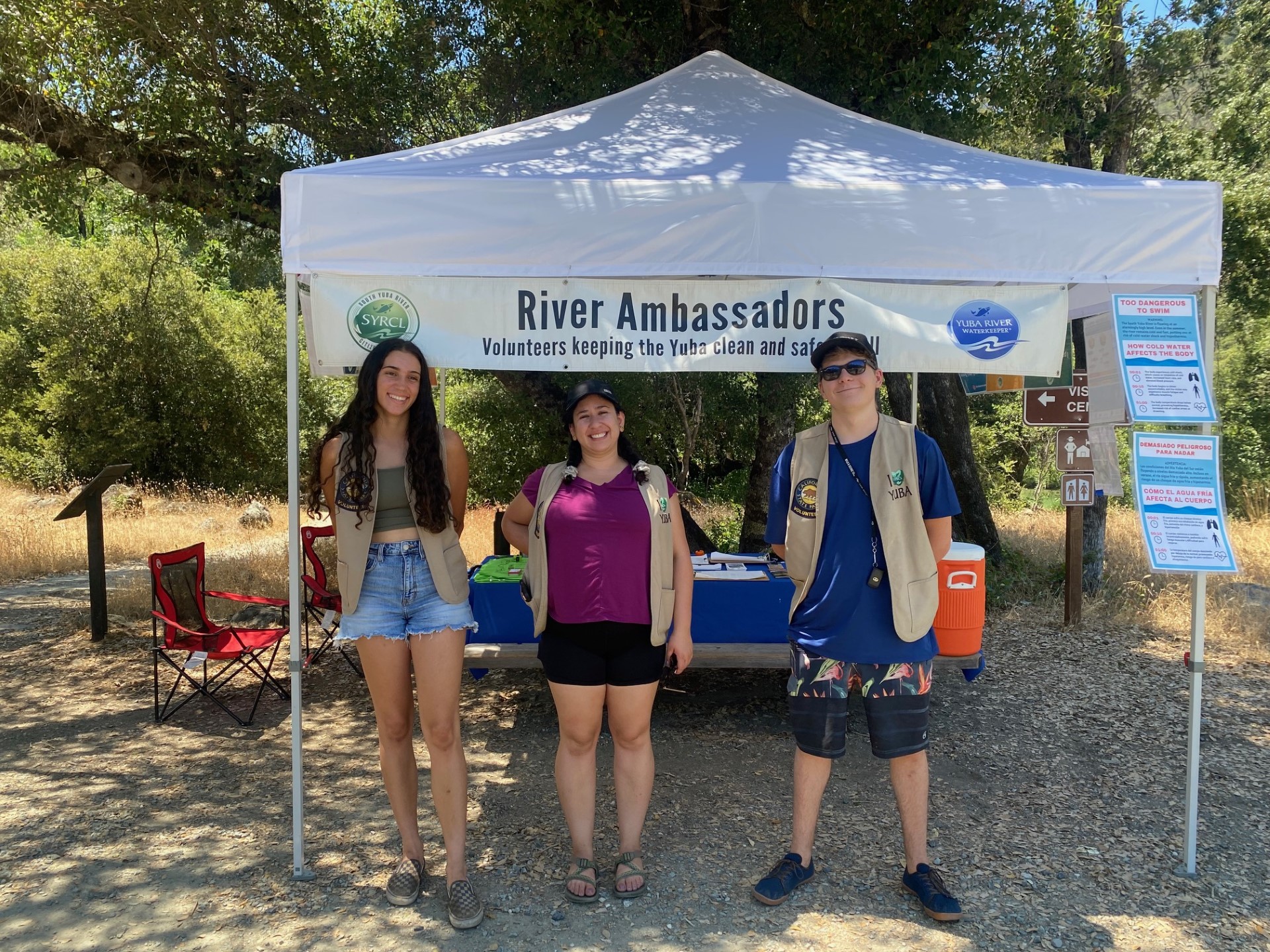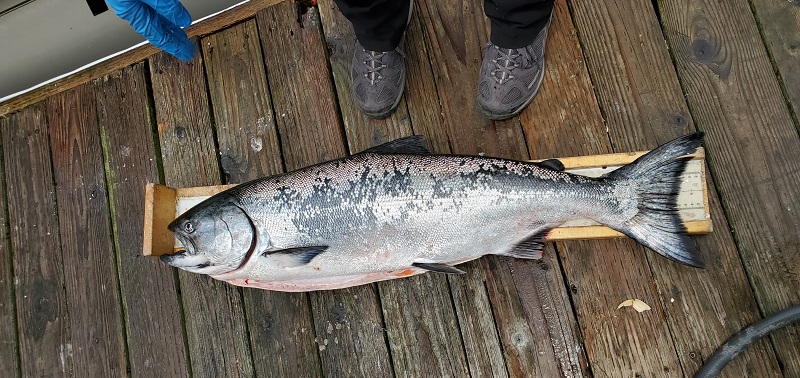California can’t afford the Idaho-Maryland Mine
By: Gianna Setoudeh
Policy Director, South Yuba River Citizens League
In 2019, Rise Gold Corp., a private company based out of Canada, submitted plans to the Nevada County Planning Department outlining a proposal to reopen the long-abandoned Idaho-Maryland Mine – hidden away beneath the vibrant community of Grass Valley, an archive of toxic mine waste and an intricate underground tunnel system dating back to the Gold Rush Era of the 1800s.
In a community still recovering from the legacy effects of past mining operations, including exposure to both physical hazards on an altered landscape and chemical hazards such as mercury contamination, acid mine drainage and arsenic, and lead and asbestos inhalation, the prospect of reawakening the mine has given rise to intense scrutiny and local activism, calling greater attention to the project’s significant environmental and public health impacts.
If you asked the average community member about the project, the sentiment is clear. Driving around the County and beyond you will see bright yellow lawn signs with the simple plea: “No Mine. Protect our Air. Water. Quality of Life.”
The project is currently under review by the Nevada County Planning Commission and will ultimately come before the Nevada County Board of Supervisors for a final vote, expected sometime in mid-2023.
As it turns out, a decision on this project is much more complex than meets the eye, particularly when considering the broader context of California’s climate policy agenda.
In the fight against climate change, the proposed reopening of the Idaho-Maryland Mine is in direct conflict with not only local climate goals and initiatives, including the County’s own General Plan, but also with the State’s climate policies and long-term goals more broadly.
A key question to consider is, what role does our community want to have in the statewide effort to fight climate change? At the local level, this requires going far beyond the simple checking of boxes and comes down to a deeper question of true leadership and ethical obligation.
Proposed operations at the Idaho-Maryland Mine would generate an overwhelming 9,000 metric tons of new greenhouse gas (GHG) emissions annually from the proposed site in Grass Valley, plus another 4,000 metric tons of new GHGs from cement manufacturing performed offsite.
Nevada County already suffers from poor air quality due to extended wildfire seasons, vehicular pollution, factory emissions and other sources of dust and particulate matter accumulation, yet the community would have to endure further air quality impacts from rock crushing, hauling, and compacting activities that could release hazardous chemicals such as asbestos and silica particles into the air during mining operations.
Further, the excessive increase in diesel truck operations, road usage, and traffic generated by this project will only exacerbate local air quality concerns, damage to roadways, and increase electricity demand equivalent to approximately 5,000 new homes. The major uptick in new GHGs from this project reaches beyond local impact and contributes significantly to the state’s carbon footprint, ultimately detracting from statewide environmental goals.
This just scratches the surface when it comes to the project’s potential environmental impacts, which also include significant impacts to water quality, groundwater resources and wildlife habitat.
These impacts are not only harmful to the community directly, but they are in direct conflict with the state’s climate agenda.
So where does the Idaho-Maryland Mine project fit in to the broader context of our state’s climate change goals, and where should we go from here?
In 2022 alone, building on the work of years’ past, California enacted a sweeping portfolio of new climate laws, ranging from codifying the state’s long-term climate goal of achieving net-zero GHGs by 2045, to prioritizing clean electricity, to enacting a strong state budget that prioritizes tens of billions of dollars in climate spending – referred to as the “California Climate Commitment.”
From building regional climate resilience, to transitioning our state’s workforce to a carbon-neutral economy, to decarbonizing buildings, to prioritizing zero-emission vehicles, all while responding to wildfires, drought, and other catastrophic climate events – forward-thinking climate action is and has been at the forefront of decision making in California.
The bottom line is that the Idaho-Maryland Mine simply doesn’t have a place on the state’s path to a cleaner, greener economy, and California simply can’t afford to be set backwards in its intentional fight against climate change.
Reopening a toxic mine with significant environmental impacts for the benefit of very few is simply not a risk worth taking, particularly as we consider our role in the larger fight against climate change in California.
Every policy decision is a chance to do better for our communities and our environment. That is why our community is relying on our local government and its leadership to do the right thing and reject the reopening of the Idaho-Maryland Mine.
Join us in person at the Nevada County Planning Commission hearing on Wednesday, May 10 at 9:00 AM at the Eric Rood Administrative Center, at 950 Maidu Avenue in Nevada City, California, to let our local government officials know this project is wrong for our community and for California.
Did you enjoy this post?
Get new SYRCL articles delivered to your inbox by subscribing to our ENews.





The author’s fact checking here is, not surprisingly, abymal. For starters, the electricity the mine will be usilizing is regional hydropower, so there are no massive GHG increases unless you want to argue that it supplant it to somewhere else.
Secondly, air quality related emissions and noise are highly regulated and easy to filter, which is indeed well within the CEQA guided EIR generated from 20,000+ pages of expert peer reviewed reputable analysis. Or is the author suggesting that is all garbage and she/SYCRL knows better?
Specifically, according to the plan, the bulk of the mine’s activity will be indoors in sound and dust insulated buildings using common technology.
Next, as I understand it the mine intends to operate mostly electric equipment and machinery, including a look even at electric haul trucks, which are about the only thing that might otherwise be diesel powered. There is an initiative in mineral extraction called “green gold” which is the scope of the mine’s stated intentions.
I’ll finish by pointing out that any initiatives that look to green-ify our planet require money, generally by way of a healthy economy. Given the fact that the FEIR defines only precisely three significant impacts (see below), and the County’s own economic impact analysis shows that it could have $65M/the local impact, AND the fact that gold and gold production are a hedge against failing economies and fiat currencies like we are on the brink of, AND that history has shown this to be the case here time and time again, this couldn’t be more of a “no-brainer” project for the BOS to approve, despite how many mis- and uninformed people show up to chant “No Mine” in unison and wave signs. Resiliency and economy go hand in hand.
The assertions in this article are absurd since the underlying assumptions are simply unsupported if not probably inaccurate.
The three impacts recognized by the FEIR by the way are the following:
1) noise on E Bennett while a water main is installed
2) trucks on 1 mile of Brunswick Rd. during local ordinance-defined hours
3) a change in scenery at the site give it will have new buildings and be occupied. However, the site plan calls for landscaping, paint schemes, and maintaining a certain look that much resembles the site now.
Read the proposal. The trucks will be diesal
The FEIR, while being incredibly long, did not do a good job addressing the numerous environmental concerns. Mitigating for, or not worsening existing environmental conditions should not be the threshold for acceptability. We must strive for improvement in the environment. Not simply “not making things worse”. Further, economic forces rarely, if ever, prove to be good environmental stewards. More gold in the world is in no way a valid justification for the damage to our community the extraction of that gold promises. This is even more important in an economy that is wholly divorced from the gold standard. The future of our community cannot be tied to outdated, resource extraction-based economic drivers which will further concentrate wealth and export it to Canada. The world doesn’t need more gold.
(printed in The Union)
If the Rise Gold mine project gets the official go-ahead from the Nevada County Board of Supervisors, detrimental consequences could result when the Idaho-Maryland Mine starts operating constantly full-swing as the company proposes.
Among the negative environmental impacts to the Grass Valley community is possible exposure to hazardous-to-health heavy metals, such as arsenic, mercury, among other toxins that can pose serious medical risks. Water will be affected.
Not merely in the great volumes of water used to clear the tunnels, but area wells can go dry as a result of underground mining with no replacement — even involving ground water contamination becoming unfit for human use and consumption. Water is the area’s precious commodity. But as company compensation for water pollution from their tailings, a special pipe will be installed along a thoroughfare so that only immediate residents can enjoy harmless potable water.
Additionally, operations can even adversely affect local wildlife over the mine’s roughly 175-acre surface area. Historically, exactly 100 years of mining hurt the habitat harming native plant and animal populations altering ecology. So understandably, local environmentalists oppose the mine’s reopening. What’s so controversial?
The major project is located too near population even though the bulk of the mining work would extend throughout unseen labyrinths up to approximately 2,585 acres underground. The company will own all mineral rights: no gold for townfolk. At least one toxic waste dumping “pond” eyesore will be created on site, too, that the company alleges their biohazards will be routinely “cleaned.” Unsafe mine water will be flushed out downstream flowing nearby.
And there’s a question of noise pollution and minute toxic dust particles as increased traffic from trucks haul out chunks of worthless rock waste to dump. Surrounding area residents could suffer even more related ill-effects.
Mining is WYSIWYG, but sometimes what you don’t see is what you get, also. They’re called problems. Complications will arise with Rise. As in life, Murphy’s Law also applies to mining.
Rise pushes safety, technology and environmentalism in a pristine media presentation, but the area still runs serious consequences with such an endeavor. Even with the use of the best state-of-the-art high tech equipment that the private company boasts owning, things will go wrong. Rise’s CEO track record leaves a lot to be desired. Mining, after all, is not an exact science. Sinkholes occurred here.
Additionally, after Rise leaves who pays cleanup for all contamination, among other things? And mining’s ranked among one of the most dangerous professions: Freak accidents occur with risks of injury, disabilities and fatalities.
There are also economic factors to be considered.
Rise touts the project will generate “hundreds of jobs” while listing only 312 in its DEIR. Why? Because if many rich veins are discovered the workforce will grow even more. There’s no guarantee locals will be mostly hired, which raises the question of where’s everybody going to live. Commute? The region routinely experiences housing shortages. Immediate neighborhood property values could plummet.
Also, there’s no guarantee that a criminal element won’t move into the area. Gold can attract very unsavory types. Early regional miners weren’t exactly all well-behaved gentry from the highest echelons of society. Many crimes were committed.
California’s history shows that with the discovery of gold the resulting Gold Rush brought in thousands upon thousands seeking their fortune so much so that the population increase soon qualified our Golden State for statehood in 1850. If Grass Valley eventually grows into a gold mining boomtown again, too great of a population influx might not be adequately sustainable. If it gets to that point, housing prices, cost of living, and property taxes most likely will increase; so, quality of life will suffer through Aspenization. The region could not only see its negative effects, but also other adverse unintended consequences of widespread economic growth. Local infrastructure might not be able to handle such huge population increases. So, Grass Valley’s once small town charm could possibly dissipate, replaced on the map by being known as a premier industrial mining center solely and less a favorable tourist destination.
Putting gold back into “Gold Country” seems favorably nostalgic, a wish back when gold was king here, but it has unforeseen far-reaching repercussions. Is the town prepared to expand? More importantly, does Grass Valley want to? Does the town want to grow larger?
There’s nothing controversial about any of this at all? What’s that saying? All that glitters isn’t gold. All that glitters is Rise’s gold.
The Nevada County wants its tax revenue. Done deal.
As a gold miner honestly the world has no idea of the leaps and bounds they must go through. Water treatment plants constant epa inspections msha requirements. This mine is only a positive for the community. They will pump millions into the area. A certain percentage has to be local work force. The train and provide a incredible benefits package.